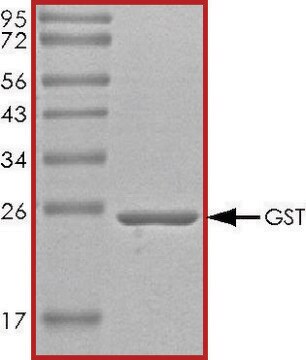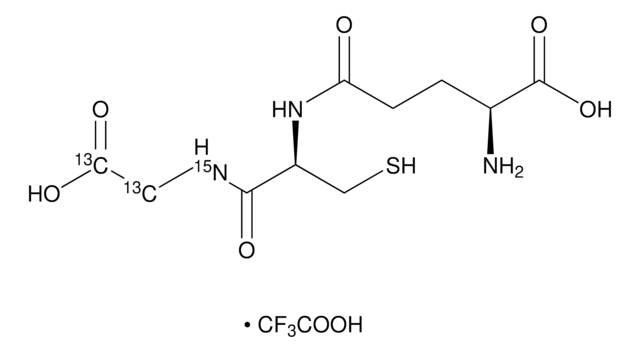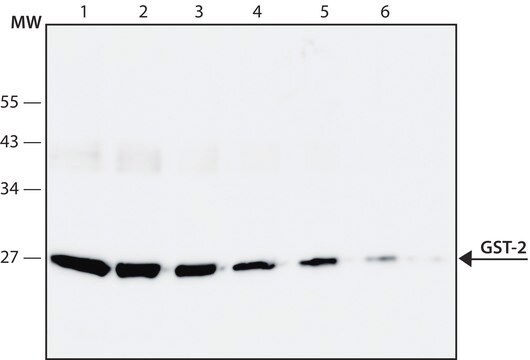G5663
Glutathione S-Transferase from E. coli
recombinant, expressed in E. coli, buffered aqueous solution
Synonym(s):
Glutathione S-alkenetransferase, Glutathione S-alkyltransferase, Glutathione S-aralkyltransferase, Glutathione S-aryltransferase, Glutathione S-epoxidetransferase, RX: Glutathione R-transferase
Sign Into View Organizational & Contract Pricing
All Photos(1)
About This Item
Recommended Products
recombinant
expressed in E. coli
grade
Molecular Biology
for molecular biology
form
buffered aqueous solution
mol wt
26 kDa
concentration
>0.1 mg/mL
>1 unit/mL
UniProt accession no.
shipped in
wet ice
storage temp.
2-8°C
Gene Information
human ... GSTM1(2944)
General description
Glutathione S-transferase (GST) catalyzes the addition of the glutathione thiol group to a suitable electrophilic species. Enzymatic activities are based on the conjugation of reduced glutathione in the presence of a second substrate.
Specificity
Glutathione S-transferase (GST) catalyzes the addition of the glutathione thiol group to a suitable electrophilic species. Enzymatic activities are based on the conjugation of reduced glutathione in the presence of a
second substrate.
In ELISA, 0.5 μg of recombinant glutathione S-transferase is the minimum detectable level of enzyme with an anti-glutatione S-transferase, alkaline phosphatase conjugate.
In immunoblot, 50 ng of recombinant GST is the minimum detectable level of enzyme with an anti-glutathione S-transferase, alkaline phosphatase conjugate.
second substrate.
In ELISA, 0.5 μg of recombinant glutathione S-transferase is the minimum detectable level of enzyme with an anti-glutatione S-transferase, alkaline phosphatase conjugate.
In immunoblot, 50 ng of recombinant GST is the minimum detectable level of enzyme with an anti-glutathione S-transferase, alkaline phosphatase conjugate.
Application
Glutathione S-Transferase (GST) from E. coli has been used in the standard curve preparation for the quantification of GST-V5H6 produced by enzyme-linked immunosorbent assay (ELISA).
Suitable for use in ELISA and Western blot applications.
Biochem/physiol Actions
Glutathione S-transferases (GST) catalyzes the conjugation of reduced glutathione with several substrates, which leads to detoxification. It also serves as transport proteins.
Warning
Due to the sodium azide content, consult the SDS for information regarding hazards and safe handling practices.
Unit Definition
One unit will conjugate 1.0 micromole of 1-chloro-2,4-dinitrobenzene with reduced glutathione per minute at pH 6.5 at 25 deg C.
Physical form
GST is supplied as a solution in phosphate buffered saline containing 0.02% sodium azide. Every lot of material supplied will have 5 mg total enzyme, at a concentration greater than 0.1 mg/ml, typically 1.0 mg/ml.
Storage Class Code
12 - Non Combustible Liquids
WGK
nwg
Flash Point(F)
Not applicable
Flash Point(C)
Not applicable
Choose from one of the most recent versions:
Already Own This Product?
Find documentation for the products that you have recently purchased in the Document Library.
Customers Also Viewed
Ji Qiu et al.
Methods in enzymology, 500, 151-163 (2011-09-29)
Systematic study of proteins requires the availability of thousands of proteins in functional format. However, traditional recombinant protein expression and purification methods have many drawbacks for such study at the proteome level. We have developed an innovative in situ protein
Living recombinant Saccharomyces cerevisiae secreting proteins or peptides as a new drug delivery system in the gut
Blanquet S, et al.
Journal of Biotechnology, 110(1), 37-49 (2004)
Single-step purification of polypeptides expressed in Escherichia coli as fusions with glutathione S-transferase
Smith D B and Johnson K S
Gene, 67(1), 31-40 (1988)
Clinical pathology in non-clinical toxicology testing
Haschek and Rousseaux's Handbook of Toxicologic Pathology, 565-594 (2013)
Niroshan Ramachandran et al.
Methods in molecular biology (Clifton, N.J.), 328, 1-14 (2006-06-21)
Protein microarrays are a miniaturized format for displaying in close spatial density hundreds or thousands of purified proteins that provide a powerful platform for the high-throughput assay of protein function. The traditional method of producing them requires the high-throughput production
Our team of scientists has experience in all areas of research including Life Science, Material Science, Chemical Synthesis, Chromatography, Analytical and many others.
Contact Technical Service





